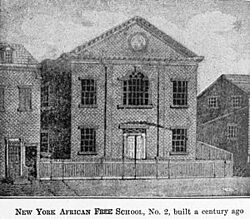African Free School facts for kids
Quick facts for kids African Free School |
|
|---|---|

Lithograph of second school, 1922, after an 1830 engraving from a drawing by student Patrick H. Reason
|
|
| Location | |
| Coordinates | 40°43′10″N 73°59′58″W / 40.719343°N 73.9994937°W |
| Information | |
| Type | Charity, segregated |
| Patron saint(s) | New York Manumission Society |
| Established | 1794 |
| Founder | John Jay Alexander Hamilton |
| Closed | 1835 |
| Head teacher | Charles Andrews (1809-1832) |
| Last updated: 30 December 2017 | |
The African Free School was a special school in New York City. It was for children of enslaved people and those who were already free. The school was started on November 2, 1787. It was founded by members of the New York Manumission Society. Important people like Alexander Hamilton and John Jay were part of this group. Many students from this school later became important leaders in the Black community in New York.
Contents
History of the African Free School
Founding and Early Goals
The African Free School was created by the New York Manumission Society. This group worked to completely end slavery in New York. In 1785, they helped pass a state law. This law stopped the sale of enslaved people brought into New York. It also made it easier to free enslaved Africans.
The society's members were all wealthy white men. They included John Jay, a statesman who was against slavery, and Alexander Hamilton.
Growth and Teaching Methods
The first school opened in 1794. It was a one-room schoolhouse with about 40 students. At first, the Manumission Society hired white teachers. But later, they also hired Black teachers. This school was an early example of "charity schooling." It was supported by donations to help the city's poorest residents.
In 1809, Charles C. Andrews was hired as a teacher. He was an immigrant from England. Andrews used a teaching method called the "monitor system." In this system, older students, called "monitors," helped teach younger ones. This allowed one teacher to manage very large classes, sometimes with hundreds of students.
Andrews strongly believed that his Black students were just as smart as white students. Under his leadership, the school grew a lot. In 1815, it moved to a new building on William Street. Five years later, an even bigger school opened on Mulberry Street. By then, almost 700 students were enrolled. The schools became well-known for their success. Andrews even published a book in 1821 about their achievements. Visitors to the city often stopped to see the schools.
Challenges and Changes
The school continued to grow, opening another building. Enrollment soon went over a thousand children. But in the early 1830s, a problem arose. Charles Andrews publicly supported the idea of Black Americans moving to Africa. This was a very debated topic at the time. Most Black Americans were born in the U.S. and wanted equal rights here.
Black students protested by not attending the schools. Because of this, Andrews was dismissed in 1832. The school then hired Black teachers to replace the white teachers.
By 1835, the African Free School stopped being a private charity. It had seven buildings in different neighborhoods. Thousands of boys and girls had been educated there. At this time, the African Free Schools and their buildings became part of the public school system. This happened a few years after New York officially freed its last adult enslaved people.
New York had passed a gradual emancipation law in 1799. This law said that children born to enslaved mothers would be free. However, they had to work as "indentured servants" for many years. Boys worked until age 28 and girls until age 25 before they were fully free. Over time, all existing adult enslaved people were freed. The last ones gained their freedom in 1827.
Notable alumni
- Dr. James McCune Smith: The first African American to earn a university medical degree. He was also a doctor, writer, and worked to end slavery.
- Ira Aldridge: A famous actor and activist against slavery.
- Alexander Crummell: A minister and an early leader who promoted Black pride and unity.
- George T. Downing: A successful caterer and a strong voice against slavery.
- Henry Highland Garnet: A minister and a leading abolitionist.
- Patrick H. Reason: A skilled engraver.
- Charles Lewis Reason: The first African-American college professor and an abolitionist.
- Samuel Ringgold Ward: A cousin of Henry Highland Garnet and an abolitionist.

